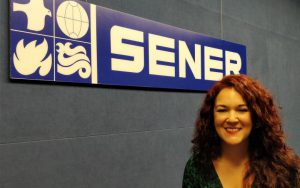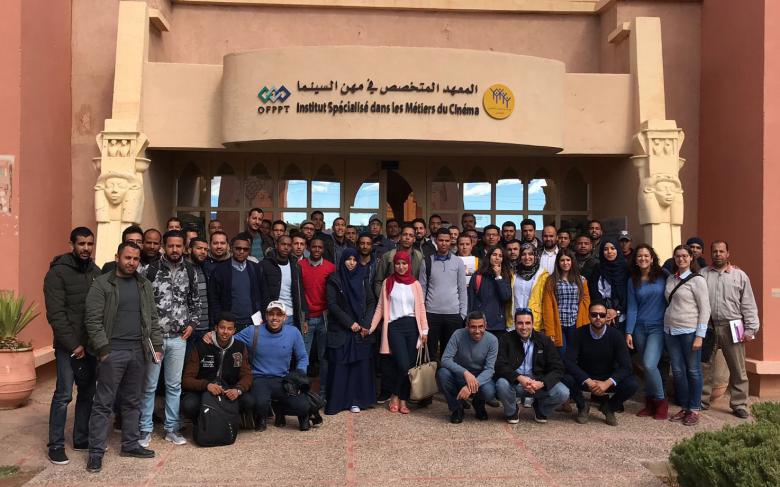Interview with Carolina Vélez, head of the NOORo II and NOORo III training program
2018.03.29 From: engineeringandconstruction.sener
Carolina Vélez, head of the Training Cycle of Young Talents in Solar Power Plants of NOORo II and NOORo III tells us her experience. After the success of the first edition, last March, the second personnel training program of the plant started, this time focusing on the NOOR Uarzazat III thermoelectric solar plant. This initiative to transfer technical knowledge is framed in the actions that the company usually carries out in the area of Corporate Social Responsibility (CSR).

What are your main criteria for selecting candidates?
The criteria used for selecting the candidates who may access the course were wide-ranging and were accepted by all parties. The objective of the course lies in the promotion of local employment and the improvement of career prospects and opportunities for the municipality and surrounding areas.
Our selection scale considers previous professional experience, significant experience in NOOR projects, the competencies identified during interviews, the place of birth or residence, and the candidates’ potential according to the professional profiles required in our solar thermal plants. Throughout the training programme, our instructors and coordinators were able to evaluate the competencies of all the students, as well as their performance, involvement and test results. In this way, we have been able to identify the best candidates to incorporate into our organisation.
In the first training stage, how do you evaluate the candidates’ level of knowledge and expertise?
We started with a minimum profile, which we originally defined keeping in mind the legislation of the country, and which ensured a sufficient knowledge base so that the students could continue to learn and acquire technical knowledge about our factories.We even had candidates with engineering training. In the first edition of the training, which was focused on NOOR II, we had candidates who were experienced in NOOR projects, but also people with no experience who had huge potential.
How would you evaluate this first experience?
It’s not the first time that we in the SENER group have organised this type of initiative. We had a pathway in the training courses for the Spanish solar thermal plants, the Gemasolar and Valles plants, through Torresol Energy. However, it’s the first time that we are exporting a successful training model outside Spain.
It’s been a great experience, both because of the final result, since we have covered the intended positions, and also others with a higher-level profile than expected, according to personal experience. This type of programme helps us to create links with the community and the authorities but, most importantly and most valuably, it allows us to establish a close relationship with the students who will later become our employees.
Did it help you identify Moroccan talents? If so, for which posts have they been selected?
Of course. It was the aim of the course. What surprised us is that we identified higher-level profiles than we expected.
How many candidates do you expect for the second training stage?
When we made the proposal to Masen, the University of Ouarzazate and the OFPPT (Office of Professional Training and Work Promotion), we intended to set up courses with 50 students. In light of the results obtained in the first edition, we have extended the scope of the second edition to include an extra 10 people. We have selected similar profiles with technical training and, also, slightly higher-level profiles, for the purpose of covering posts in the control room with students who have engineering training and a Master’s in renewable energy.

How many will be chosen? For what kind of work?
We expect between 25 and 30. The final number depends on the development of the course and the students’ performance.The work is varied and includes solar park cleaners, site operators, power module workers and maintenance technicians, both mechanical and electrical, as well as instrumentation and control. At the end of the training programme at NOOR II and NOOR III, SENER, with the support of its local partners, Masen and the OFPPT, will train more than 100 local individuals, offering them a real opportunity to develop their own specific skillset. This undoubtedly makes them better prepared to access the renewable energy project job market. Furthermore, the OFPPT and Masen will be able to continue providing training projects of this kind to improve general knowledge about thermal solar energy and the renewable energy sector.
What is the difference between the two programmes?
he first edition was developed for the NOOR II factory, that is, for parabolic cylinder technology. This second edition is concentrated on NOOR III, which concerns the tower technology.
Do the NOOR II and NOOR III plants require different profiles? Different technologies?
The profiles are similar. In all the factories there are operating, training, safety and environment departments, as well as financial support, administrative and human resource departments. The way in which the factories are internally organised depends on the marketing strategy of each operating company.
How many modules and hours are planned for the second stage of training?
SENER’s Operation & Maintenance team has invested more than 4500 hours per year in order to prepare for the course training, implementation and follow-up. For this second edition, 15 training modules are scheduled over 2 months, so that’s more than 300 hours of training.
In your opinion, what are the advantages of this training for the company?
For SENER, the implementation of the training is an amazing opportunity to meet and approach local talent. It allows us to spend a few months with the students to get to know their situation, their work dynamic and their day-to-day performance, through the way in which they address exercises and exams. All these factors reveal the huge potential of the local participants.
Without a doubt, this type of action allows companies to create links with the local community and establish a pool of specialist, trained individuals. Don’t forget that some of the students who complete the course and obtain their certificate can become future employees, future partners.

In your opinion, to what extent does this type of training open up employment opportunities for young talented Moroccans?
First of all, it’s an opportunity for many of them to start building a solid CV and to understand the complexity of a macro project on renewable energy using cutting-edge technology. Secondly, it’s important to mention that these factories, which use very advanced technology and adhere to rigorous standards and procedures, need trained, experienced personnel. This is true for NOOR, but also for all solar thermal projects worldwide.
In this regard, we open a door and generate interest so that they can develop a professional career in renewable energies. Furthermore, it is essential that the young talents understand that, in order to work in technology, training is essential, since many jobs require previous training and experience.
Do you intend to replicate this initiative in other areas or other projects?
The training format within the solar thermal plants is a project that will last for several years. This initiative was created for thermosolar factories in Spain, Gemasolar and Valle I and Valle II, for which a comprehensive training programme has been developed. The model for the solar thermal plants in which SENER is involved in Spain was so successful that it was decided that it be replicated.
Are there plans to ensure the continuity of this training programme?
SENER only manages the NOOR II training programme, which has already finished, and NOOR III, which is currently in progress. However, when the agreement was signed with the OFPPT and Masen, and for the purpose of preserving the renewable energy training, the training of Moroccan professors by the SENER coordinators themselves has also been envisaged so that local institutions can replicate courses with the same training programme in the future.
Relevant CSP Conference:2018 CSP Focus Conference(June 27-28 Morocco)
More from CSP Focus
NextIRENA: 140 Gigawatts of Solar and Wind Capacity Installed Globally in 2018
Chile’s Cerro Dominador concentrated solar power signs PPA with power distributor Saesa
World biggest concentrated solar power tower with storage NOORo 3 starts commissioning
Industrial Solar completes commissioning of a micro-Concentrated Solar Power system in Qatar
Researchers Work to Develop High-Temperature Concentrated Solar Power System
WCE provides Molten-Salt Heat Exchangers for China 1st 50MW CSP plant in Delingha
Emerson Completes Acquisition of General Electric’s Intelligent Platforms Business
CSP capex costs fall by almost half as developers shift towards China and Middle East
Solar CSP core technology R&D to boost the expansion of Shanghai Electric
Leave your thoughts here
Reports(Member Only)
See more+-
CSP Focus Membership Proposals
We are now proposing CSP Focus Membership, hoping to better serve our members to keep pace with the latest updates of ongoing CSP projects worldwide, and to establish and maintain business relations with major shareholders of the projects. CSP Focus offers to Membership exclusive access to:1. Daily/Weekly update and analysis on CSP policies, projects, technologies, market trend and corporate relea
-
The Latest CSP Focus Monthly Update
Join CSP Focus Membership to Get the Latest CSP Focus Monthly Update December Edition.
-
CSP Project Monthly Update 2022 December Edition
CSP Focus is presenting CSP Project (China) Update 2022 December Edition.Detail report is available for CSP Focus Membership.
-
Presentations-CSP Focus China 2021
The Report is for CSP Focus Members only.
Upcoming Events
See more+-
12th CSP Focus China 2022
2022.04.21-22 Beijing
-
11th CSP Focus China 2021
2021.10.28-29 Beijing
-
10th CSP Focus China 2020
2020.10.22-23 Beijing, China
Project Updates
See more+-
Lanzhou Dacheng Dunhuang CSP Project
Asia Pacific-China,Operational,Parabolic Trough
-
Luneng Haixi 50MW Molten Salt Tower CSP Project
Asia Pacific-China,Operational,Power Tower
-
Dubai 950MW NOOR Energy 1 CSP+PV Project
MENA-UAE,Under construction,Power Tower
-
Power China Gonghe 50MW Molten Salt Tower CSP Project
Asia Pacific-China,Operational,Power Tower





